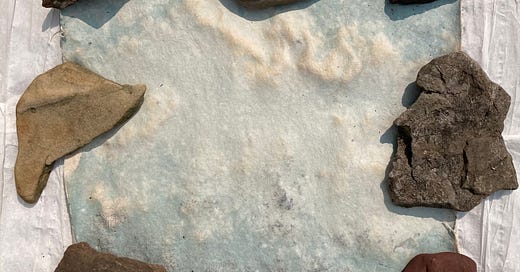A few people have responded to my previous post on ecologies of creativity, particularly around this point about creativity being potentially something that can be extractive, so I thought I would make a follow up post.
Creativity is something that I talk about a lot because the visual arts are my disciplinary home, and it follows that I would have something to say about it. Also, I have a teaching and mentorship practice, Drawing on the Senses, in which I facilitate sense-based explorations into creativity and the development of creative practices.
These are not, however, the only contexts in which it is important to think about creativity. Creativity is not just something that artists do. In my previous post, I gestured towards the theological origins of notions of creativity, and its secularization and individualization in the Enlightenment. For a deeper dive on this, I recommend my friend and collaborator Beatrice Marovich’s post A History of Creativity: capitalism and the changing shapes of a once-divine power. Her post traces the history of the use of the word “creativity,” as well as capitalism’s usurpation of it as a term, tool, product and lifestyle.
What I want to do, here, is think about how we use the idea of creativity to define and understand ourselves, and, perhaps more importantly, to think about how this frames our relational thinking. As I’ve said before, creativity is one of those words, like spirituality, or consciousness, that people frequently use without any real conviction about what it is, while at the same time holding (often self-limiting) beliefs about who has it, where it is found, and what it produces.
I understand creativity to be the aliveness of our relations with the worlds in and around us (Beatrice might say that it is both the life and death of those relations that contributes to or produces that aliveness). To go further, I would say that this aliveness engages us as creative extensions of its will towards the production of more aliveness (and for more on this, I recommend Sophie Strand’s post The Endless Baptism of Freshly Created Things).
Why does this matter? Let me give you an example. A phrase we might hear in conversations about any kind of contemporary problem, let’s take climate change, for example, is: the challenges of our day require creative solutions. This is a very common tagline for any number of organizations, conferences, businesses or products. The phrase stirs a kind of ramping up, an all hands on deck type of energy that is a contemporary invocation of the promise of modernity. Modernity centralizes knowledge, specifically human knowledge and mastery. It holds us in the age old binary of humans and the world, the world being something we humans are always outside of. Humans do and the world reacts, and this all exists on a linear timeline of causes and effects.
This kind of thinking, while highly marketable and, on the surface, widely palatable, is isn’t existing outside of the set of behaviors and ideas that have led us to the challenges it is purportedly aiming to solve. We messed up the world and now we’re going to fix it (creatively) is an ethos that continues to center the superior capacities of our human minds, while simultaneously ignoring that the “human” is not a concept equally extended to all our sapien kin. Centralization excludes the margins, and the margins is where the debris of modernity’s hubris settles into ecosystems, into nests, crops and drinking water, lungs and breast milk with the heaviest of consequences.
When we practice creativity as relational, we decentralize knowing. Knowledge is provisional, it is change, happening collaboratively, responsively, moment to moment. Creativity as relational isn’t solutions-oriented. As I often say to my students: there’s no it to get. There isn’t a meaning we arrive at in our work (nor do we find “it” in the the works of others).

Creative practice isn’t about mastery. It isn’t about being good at shading or color mixing. It isn’t about having the best ideas. It is about unknowing, and that unknowing creates space for monstrously strange and beautiful forms of emergent aliveness, chimeras of marginal meanings and erotic transformations drawing us into strange new shapes and territories. When we are engaged in a process of really understanding our creativity as relational, as something that happens through being in deeply entangled relationships with the world in around us, the dualisms that bind us into extractive antagonisms with the world begin to loose shape, and we begin to loose shape with them. We accept that the comfort we had derived from the familiar may not be the ethics that will guide us into the new. It is neither easy nor comfortable, but it is a process that can open us to experiences of aliveness that touch and teach us in ways we could not have imagined.
If you are enjoying these posts, please consider becoming a paid subscriber. In addition to supporting this work, paid subscribers also receive access to the Drawing on the Senses exercises. New ideas need a practice, a way of working with them, feeling into them and noticing how they take shape in our bodies and inform our perceptions.
You can access the exercises on the Drawing on the Senses page.
Lastly, I’m pleased to share that the compost co-post by Beatrice and I, Becoming Earth, has been published on Science & Non-Duality. Thank you, readers, for being a space where we can explore these ideas together.



